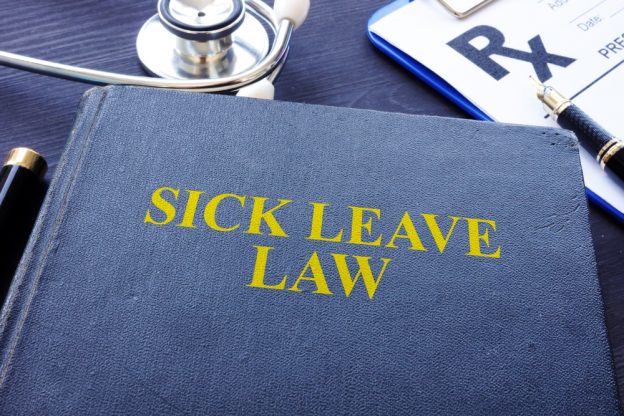by: Ryan Biesenbach
On April 3, 2020, Governor Cuomo passed Assembly Bill A9506B, granting most New Yorkers paid annual sick leave through New York State’s Permanent Sick Leave Law (“NYSPSL”). The law was passed as part of a multitude of legislation enacted in response to the ongoing COVID-19 pandemic. The law was adopted as part of the FY 2021 Executive Budget. This law is now in full force and effect across New York State.
Although eligible employees were not entitled to use any sick leave accrued under the new law until January 1, 2021, eligible employees began to accrue sick leave as of September 30, 2020 (or upon hire if after this date) at a rate of at least one (1) hour for every thirty (30) hours worked. Alternatively, employers may elect to frontload the total amount of sick leave at the beginning of the calendar year.
The amount of sick leave under NYSPSL is determined by an employer’s size and net income in a given calendar year:
- Employers with four (4) or fewer employees and a net income less than $1 million must provide at least forty (40) hours of unpaid sick leave per calendar year.
- Employers with five (5) to ninety-nine (99) employees, and employers with four (4) or fewer employees and a net income greater than $1 million must provide at least forty (40) hours of paid sick leave per calendar year.
- Employers with one hundred (100) or more employees must provide at least fifty-six (56) hours of paid sick leave per calendar year.
On December 9, 2020, the New York State Department of Labor (“NYSDOL”) published proposed regulations, clarifying certain issues related to NYSPSL. The key takeaways from the NYSDOL include the following.
Documentation of Eligibility for Leave
Employers are prohibited from requiring employees to provide “medical or other verification in connection with sick leave that lasts less than three consecutive previously scheduled workdays or shifts.”
Employers are prohibited from requiring employees to pay any cost or fee associated with obtaining medical documentation.
Employers are prohibited from requiring an employee to provide confidential information, including the nature of an illness, its prognosis, treatment, or other related information. Additionally, an employer cannot require an employee to disclose any details or information regarding leave taken pursuant to NYSPSL.
Except where prohibited by law, an employer may request documentation from an employee confirming their eligibility to take sick leave where the employee uses leave for three or more consecutive and previously scheduled workdays or shifts. Requests for documentation are limited to: (i) an attestation from a licensed medical provider supporting the existence for a need for sick leave, the amount of sick leave needed, and a date that the employee may return to work; or (ii) an attestation from an employee of their eligibility to take sick leave.
Counting Employees
The number of employees during a calendar year is determined by counting the highest total number of employees concurrently employed at any point during the calendar year to date.
For employers that increase the number of employees during a calendar year above any of the relevant thresholds described in NYSPSL:
- The accrual of additional required leave is prospective from the date of the increase and does not entitle employees to reimbursement for previously used unpaid leave, or to use more than the maximum amount of leave as required under NYSPSL;
- Prior accruals of used and unused paid leave and used unpaid leave in a calendar year may be credited by an employer toward any increased paid leave obligations under NYSPSL. Employers may not credit any prior accrual of unused unpaid leave toward any paid leave obligations; and
- Employees must retain any existing accrued paid and unpaid sick leave, notwithstanding an increase in the number of employees during a calendar year.
Employers are prohibited from reducing leave entitlements based on a reduction in the number of employees until the following calendar year.
Employers are required to count employees on paid or unpaid leave, including sick leave, leaves of absence, disciplinary suspension, or any other type of temporary absence, as long as the employer has a reasonable expectation that the employee will later return to active employment. If there is no employment relationship (as when an employee is laid off or terminated, whether temporarily or permanently), the individual need not be counted.
Employers are required to count part-time employees as employed on each working day of the calendar week.
Employers are required to count employees who are jointly employed, regardless of whether they are on the employer’s payroll records.
Accruals
Employee accruals of leave must account for all time worked, regardless of whether time worked is less than a thirty (30) hour increment.
For calculating accruals for time worked in increments of less than thirty (30) hours, employers may “round accrued leave to the nearest five (5) minutes, or to the nearest one-tenth or quarter of an hour, provided that it will not result, over a period of time, in a failure to provide the proper accrual of leave to employees for all the time they have actually worked.”
As a result of the new regulations, New York State employers should review and update their current sick leave policies and practices to conform with the requirements of NYSPSL. This includes communicating changes in policies and practices to employees and training supervisory, managerial employees, and human resources departments on the requirements under NYSPSL. Employers should also review and update existing handbooks, policies, and procedures to ensure compliance with NYSPSL.
For more information on how this case may impact you, your employment, or your business, please do not hesitate to contact the professionals at Zabell & Collotta, P.C.
